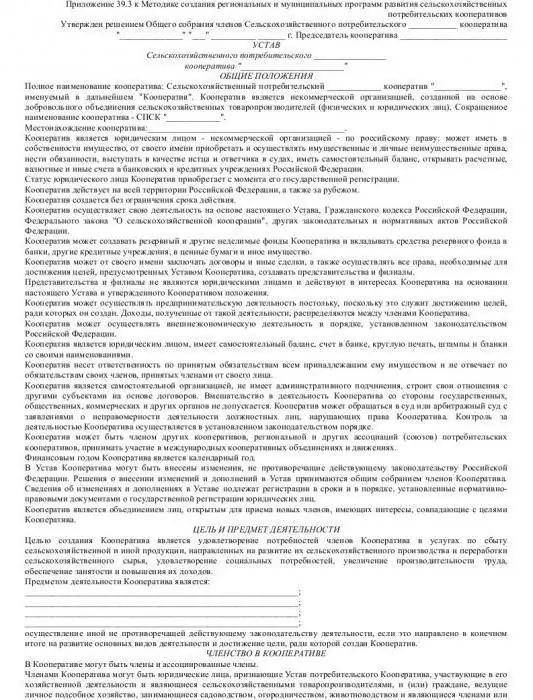2025 Author: Howard Calhoun | [email protected]. Last modified: 2025-01-24 13:10:27
Agricultural production cooperative, agricultural artel and other types of public organizations associated with similar business sectors are becoming increasingly popular. There is a simple explanation for this fact: such structures allow you to combine the efforts of several individuals or legal entities, which greatly facilitates the achievement of various goals within the framework of entrepreneurship. Moreover, such a format of association makes it possible to successfully scale operations and reach new levels of productivity.
Relevance of cooperation
When such a term as "agricultural cooperative" sounds, you need to understand that we are talking about an organization created by agricultural producers or those who run personal subsidiary plots.

The basis for the formation of such a structure is voluntary membership, and joint production or any other activity can be considered as the purpose of creation.
In turn, to start the business as such, it is necessarythe presence of a pool of property share contributions of participants in the cooperative. This will meet the material needs of the organization.
It is also important to understand that an agricultural cooperative can be both consumer and production. Each of them has its own characteristics and purposes.
It is worth noting the fact that in different countries the principles of cooperation are basically the same, and the differences cannot be called significant. For example, an integral characteristic of such structures is the democracy of the management mechanism. That is, everyone has the right to vote, regardless of the size of the share, including when it comes to choosing the governing bodies. Such elections, as well as the resolution of important issues, can only be held by a general vote.
Basic concepts
In order to have a complete understanding of what an agricultural cooperative is, you need to pay attention to key terms. These definitions are constantly used in describing various areas of activity of structures organized in the format of cooperation.
You can start with a membership. So, a member of a cooperative is a legal or natural person that meets all the requirements of the current Federal Law and the charter of the organization itself. Also, the participant of the organization is required to make a share contribution in the prescribed amount. If everything was done according to the accepted order, then the new member of the organization receives the right to vote.
Subsidiary liability of cooperative members is also a term worth paying attention to. ATIn this case, we are talking about additional obligations that are not related to the standard list of requirements for a participant when making a contribution. Such additional liability may be relevant, for example, in a situation where creditors have presented legal requirements to the cooperative, but the organization is unable to fulfill them within the prescribed time frame. It is worth once again paying attention to the fact that both the size and the degree of subsidiary liability are determined by the charter of the structure and the legislation of the Russian Federation.
An employee in such organizations should be understood as a person who is not a member of the organization and involved in a certain type of activity through an employment contract.
It is also important to understand what an agricultural producer is. We are talking about a legal or natural person who is engaged in the production of any product. At the same time, the percentage of agricultural products from this category should be more than 50% of the total volume of products produced by a particular company.

It is worth mentioning such a phenomenon as a share contribution. This term should be understood as a contribution made by a member of the cooperative to the unit fund of the organization. It can be finance, land and any property, as well as property rights that have a monetary value. There are both basic and additional shares.
Cooperative payments are nothing more than payments to members of the organization according to the contribution and labor activity of each of them.
Cooperative Membership
In such an organization, the presence of two categories of participants is possible: ordinary members of the cooperative and associated. In the first case, we are talking about individuals and legal entities. Moreover, the consumer form of cooperation implies participation in the activities of only individuals. Each of the members of the organization is obliged to pay a share contribution in the manner and amount that was established. Such participants bear responsibility (subsidiary) additional to the main obligations and are accepted into the structure with subsequent voting rights.
As for the associated type, in this case we are talking about legal entities or individuals who have made a share contribution and receive dividends on its basis. Also, as part of their contribution, they share the risks of possible losses caused by the activities of the organization. An agricultural cooperative with associated members allows the latter not to take an active part in economic activities.
The basis for termination of membership may be exclusion, withdrawal from the organization, transfer of a share contribution, liquidation of a legal entity and payment of funds invested upon entry, and in full. It is worth understanding the fact that the person to whom the share contribution was transferred can become a member of the cooperative on the basis of this circumstance alone.
The purpose of the agricultural cooperative
Structures of this kind, of course, are not created by chance. They perform certain tasks that are determined by the participants before the formation of the organization. Given that cooperativesrelated to the agricultural sector is the union of not only capital, but also specific individuals, the presence of goals is more than logical. Here are the principles of functioning of such organizations, which are also goals:
- democracy of governance;
- voluntary membership;
- receiving mutual assistance and economic benefits;
- additional (subsidiary) responsibility of members;
- distribution of profits according to the contribution of each participant (share contribution, performance of specific tasks);
- priority of the interests of cooperative members.

But in general, such structures are needed in order to achieve urgent tasks by joint efforts and resources. It is also important to pay attention to the fact that information about the activities of the organization is always available to its members.
Everyone who officially took part in the activities of the formed structure receives a membership book, which contains the following information: the date of accrual and the amount of the incremental, basic and additional share contribution.
Consumer cooperative
This term is used to refer to a non-profit organization owned by agricultural producers. Its management uses a democratic principle, that is, one member of the cooperative can have one vote. The manifestation of democracy can also include the desire to increase the profits of participants and provide them with the types of services that they need for their ownhouseholds.
Only on condition that at least 5 citizens and 2 legal entities become members of the structure, agricultural consumer cooperatives can be formed. The activities of such organizations exclude the participation of state unitary enterprises as members. This restriction also applies to state-owned LLCs and municipal unitary enterprises.
If necessary, you can organize cooperatives of several levels by combining individual organizations into one big one. In the future, these may be structures of all-Russian and even international significance.
It is important to remember that the key purpose of the activity must be indicated in the name of the organization, regardless of whether it is a consumer or agricultural production type. A cooperative, organizations and any structures that can be defined as associations for the purpose of effective commercial activity allow participants to reach fundamentally new horizons, including outside the country.

The advantages of an organization of this type include the possibility of obtaining direct access to producers and consumers and, as a result, a tangible strengthening of its position in the current market segment. With such resources, cooperative members become able to effectively defend their own interests both in front of processing enterprises and in front of various commercial firms.
Production cooperative
Thisa commercial organization that is created by citizens for the purpose of joint activities. We are talking about the production, processing and sale of agricultural products. Actually, this is the reason why the SEC is registered. An agricultural production cooperative, in principle, can be focused on the implementation of any activity that is not prohibited by law, but the above directions are the most popular.
Legal entities cannot be members of a production cooperative, only citizens of the Russian Federation and only those who are 16 years old. At the same time, the participants of the organization are obliged to take a personal part in its activities. It will be useful to know that the word "artel" is used to refer to cooperatives organized in the form of a collective farm.
It is interesting that the protocol of the agricultural cooperative is used to fix all the key decisions of the organization. This document displays all the information about the meeting, which, for example, decided to expel a particular member of the association or considered other issues. In the minutes you can find the names of all participants in the meeting, the purpose for which the last meeting was held, and, of course, the final decision. Such documentation allows, if necessary, to track the entire chain of important decisions of the organization.
Structure of charter
This document is the basis of the work of the organization, and without it, full-fledged activity is not possible. Therefore, the charter of an agricultural production cooperative must be formed without fail.
As for its structure, it includes several key sections, and their number can be changed if necessary. At the request of the founders of the organization, some parts of the main sections can be put into separate categories. In most cases, the structure looks like this:
1. Initially, general provisions are prescribed. It determines the fact that the cooperative is a legal entity, created without a time limit and operates on the basis of the charter. Further, information is recorded on the possibility of creating reserve and indivisible funds, the right to conclude contracts and transactions as such, as well as all types of liability, etc.
2. Goals and subject of activity. In this part, the charter of an agricultural production cooperative contains information on the purposes for which the organization is being created, and all planned activities are also clearly defined.
3. Membership. This clause of the charter determines who and under what conditions can become a member of a particular organization. This section describes the features of interaction with both individuals and legal entities.

4. Obligations and rights of cooperative members. This information block is necessary in order to determine in detail what all members of the organization have an equal right to and what obligations they assume. It also discusses possible sanctions in case of failure by the participants to fulfill their obligations under the charter.
5. Procedure and conditions for entry intocooperative and termination of membership in it. It contains information about what documents must be submitted to everyone who wants to become part of a particular association. This section also determines the procedure for filing an application and the grounds for a possible refusal. It is in this part that the features of issuing a membership book and its contents are recorded. With regard to the conditions for the transfer of a share and the conditions for leaving the organization, they are also set out in full detail. Attention is also paid to the possible exclusion of participants in the structure.
6. Governing bodies. This is an integral part of all the information contained in the charter of an agricultural consumer cooperative. A sample of such a document will help to more clearly present the structure of this section. Generally speaking, here is a list of governing bodies that must be formed without fail. Moreover, the conditions for their creation and key principles of work are fixed.

7. Property. This section is needed in order to determine in detail the structure of own and borrowed funds. It describes what constitutes the fixed capital of a non-profit organization (entry, mandatory, additional contributions, reserve fund, etc.). The procedure for distributing funds and other relevant information is also considered.
8. Reorganization, termination of activities and liquidation of the cooperative. This part is necessary in order to fix the possibility of merging and in casethe need for division. It also defines the procedure by which a particular non-profit organization can be liquidated.
9. Additional Provisions. This is the final information block that forms the charter of the agricultural consumer cooperative. A sample of any document of this type ends with it. This part is needed to fix the conditions under which any changes can be made to the charter itself. The date of preparation of the document and the number of copies with the same legal force are also indicated.
How the issue of taxation is resolved
The work of the administration in the cooperative will be focused on solving various statutory tasks, and this will require several accounts.
Thus, to account for proceeds from non-commercial activities, account 86 “Target financing” is used, on which this information is recorded. The basis for such actions is the accounting plan for financial and economic activities.
In turn, account 90 is used to account for income from the organization's entrepreneurial activities. That's why it's called Sales.
There is another account numbered 08 and called "Investments in Non-Current Assets". It is needed in order to keep records of the organization's capital investments.
It is worth paying attention to the fact that the taxation of an agricultural cooperative in the contract method of building various objects has its own characteristics. In this case, account 60 is credited for the cost of work performed, and account 08 is debited.
If the economic method is used, then the following expense items are used to maintain the costs associated with the construction of specific objects:
- materials;
- overhead;
- costs associated with the operation and maintenance of mechanisms and machines;
- for wages with deductions for social needs;
- other expenses.
If all the funds in the cooperative are used strictly for their intended purpose, then targeted revenues are not taken into account when compiling the tax base. As for VAT, according to the general rule, such organizations are obliged to pay it.
General meeting of the agricultural cooperative: authority
It is this governing body that is the highest in such a structure and has the right to make any decisions regarding the activities of the organization. The powers of the general meeting are so great that it is able to confirm or cancel the decisions of the supervisory board and the board of the cooperative.

The General Assembly also has exclusive competence in resolving certain issues. This may be, for example, the procedure for distributing profits and losses between the participants of the cooperative, the acquisition and alienation of land, as well as the organization's fixed assets, approval of the charter, amendments to its structure, determination of the size and types of funds, as well as reorganization and liquidation.
Management of an agricultural cooperative without this body is not possible. By the way, exception and acceptancemembers of the cooperative is also involved in the general meeting.
Earth issue
If we talk about land, it should be noted that such property may belong to the cooperative on the basis of ownership. At the same time, members of the organization have the right to transfer the site as a share contribution and, in the event of reorganization, can use it in the same way.
Also, the land plot of an agricultural cooperative can be purchased or have the status of association ownership for other reasons. As for the use of land, structures organized in the format of cooperation have the right to create protective forest plantations, carry out work within the framework of agricultural production, and also use land for educational and research purposes. Fish farming can also be attributed to this list.
Sometimes land plots play the role of paying a share contribution in the form of property.

Results
Such a direction of associations as agricultural cooperation is definitely promising and relevant. At the same time, it is important to know that the Association of Peasant Farms and Agricultural Cooperatives provides the most active assistance to the development of this type of cooperation in Russia. The goal of ACKOR is to protect the rights of small organizations in the field of agriculture and farmers, as well as competently promote their quantitative growth. Therefore, this format of associations is taking root more and more in the vastness of the Russian Federation.
Recommended:
TC RF Chapter 26.1. Taxation system for agricultural producers. Single agricultural tax

The article describes the features and nuances of the taxation system for agricultural producers. The rules for the transition to this system, as well as the requirements for taxpayers are given. The rules for calculating tax and accounting for income and expenses are indicated
Consumer cooperative - what is it? Credit and consumer cooperative

Consumer cooperation makes it possible to carry out business within the free economy zone and receive tax benefits. The relevance of cooperative organizational and legal forms is becoming more and more obvious. Why? What are the types of cooperation? The answers to these and no less interesting questions can be found in this article
The basic concept of a credit institution: signs, types, goals and rights

The concept of credit institutions is that their activities are aimed at the implementation of functions that ultimately lead to the development and growth of economic relations in the country and abroad, improving the welfare of the population
Logistics concept: concept, basic provisions, goals, objectives, stages of development and application

In the article we will talk about the concept of logistics. We will consider this concept in detail, and also try to understand the intricacies of logistics processes. In the modern world, this area occupies a rather significant place, but few people have a sufficient idea about it
A production cooperative is The Federal Law on production cooperatives. Legal entity - cooperative

Business is not only a means of personal enrichment, but also a way to significantly support financially that area or other entity in which the segment of small or medium-sized businesses is significantly developed. Knowing this, most of the self-government bodies actively support (sometimes not even on paper) the initiatives of citizens

